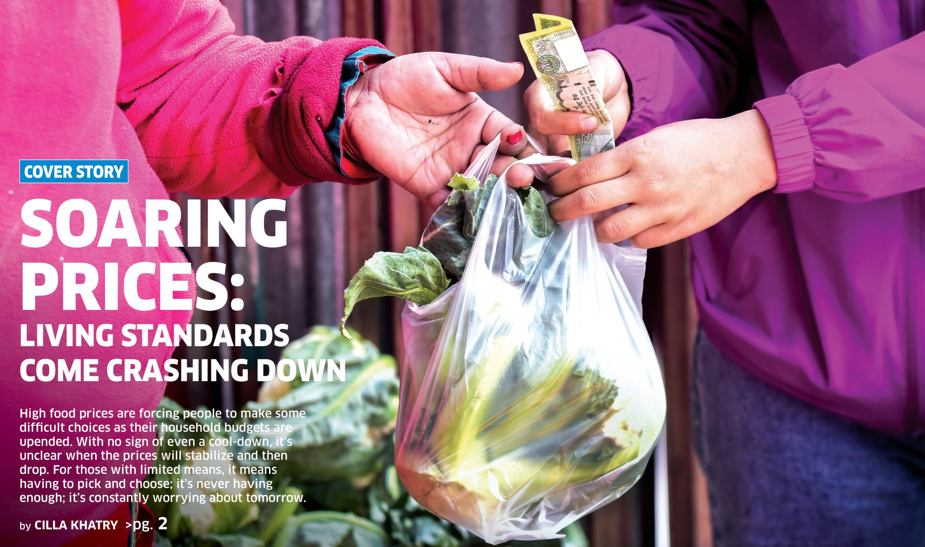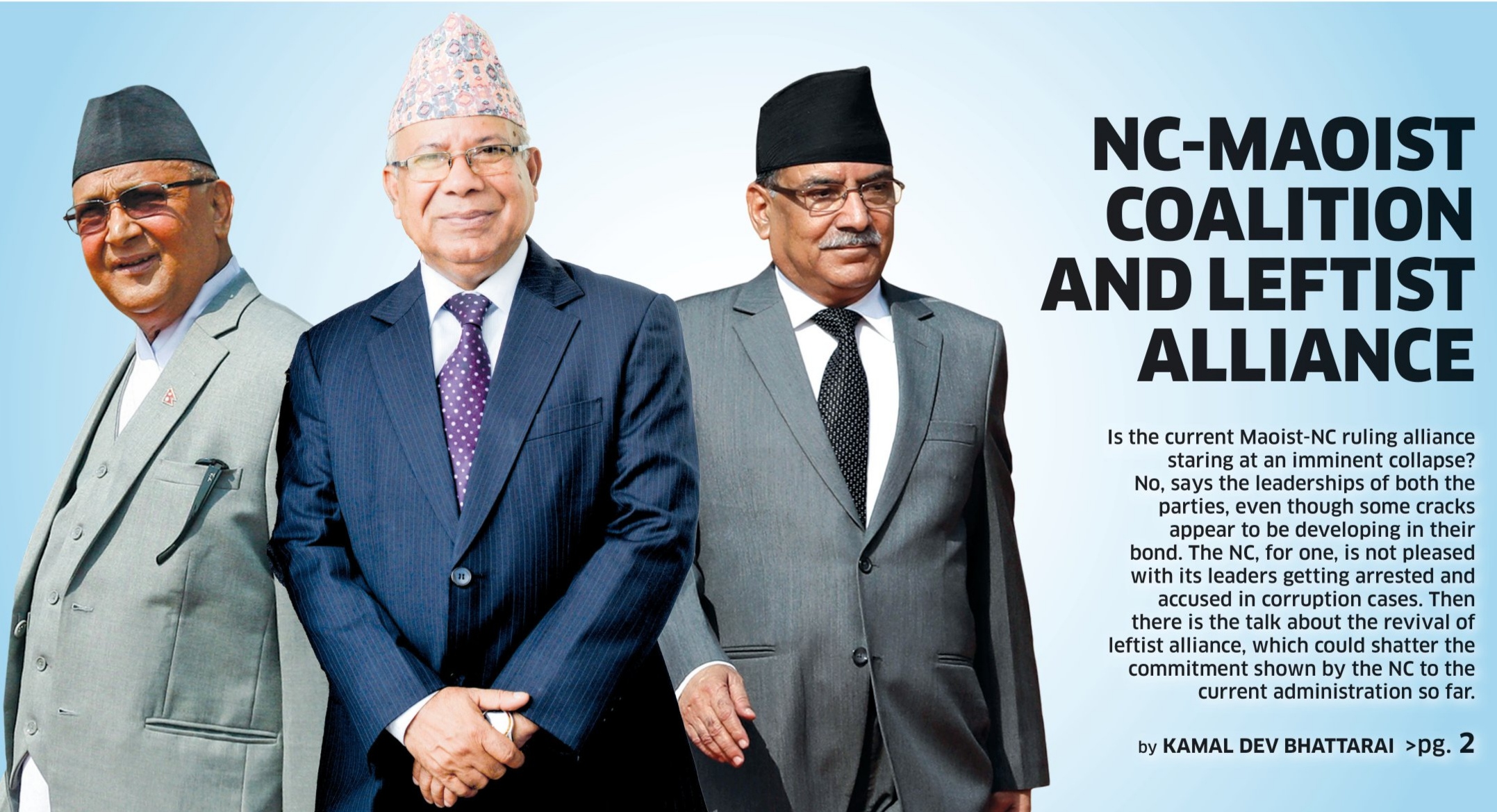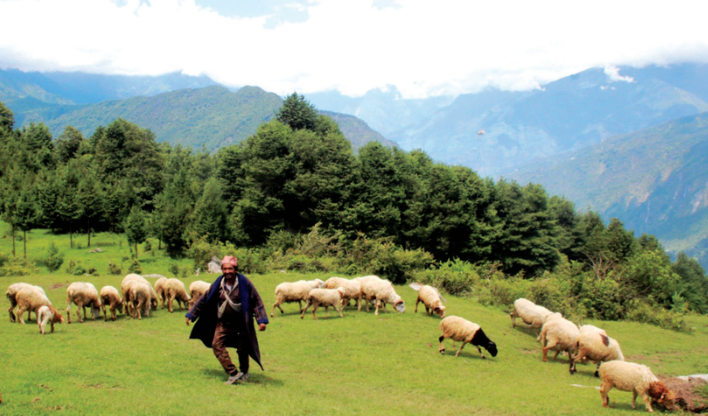Not seeing the wood for the trees
On March 8, the 113th International Women’s Day was celebrated to cherish and celebrate women’s achievements in social, economic, cultural and technological fields. Though the UN Women declared this year’s theme as DigitALL: Innovation and technology for gender equality, the situation in Nepal’s forestry sector is much poorer in terms of women’s representation, role in decision-making and their share in positions of power. This article sheds light on the need for gender-friendly technologies in the sector. Women and technology in forestry Nepal’s forestry sector plays a crucial role in underpinning livelihoods and conserving resources. Though women perform the most laborious and backbreaking duties in the sector from planting to nurturing trees to post-harvest labor, apart from doing household chores, they hardly get any role in resource management. Despite their important roles in the sector, women are marginalized and deprived of access to and control over resources and technologies. Adoption of cutting-edge technologies in the sector can support sustainable management of forests, increase output, and support effective production of forest products and services. Technologies aren’t designed so as to reduce the drudgery of women toiling on arduous field operations; this, in turn, ends up alienating women from the sector. The different dimensions of various technologies and techniques both digital—use of artificial intelligence, spatial technologies, social media—and non-digital—timber tracking, operating chainsaws, genetic selection and tree breeding, plantation and improved harvesting and transportation, industrial processing, etc—still have male domination. In addition, the practice-based traditional knowledge has not been acknowledged while introducing innovations in the forestry sector. The socialization process embedded in Nepali culture equates the use of technology with men’s job: ‘heavy equipment is made for men’. This might have advantaged women in regards to performing their biological role, but it is a gendered role and subjectivity created by a male-dominated society. Freedom of mobility restricting women’s interaction with the outside world is another reason for women’s inadequate awareness of technological innovations. Technological barriers should not be taken for granted as it’s one of the main reasons that comes in the way of their leadership development. Due to unequal tech decisions, women and men typically have different degrees of confidence in their ability to learn and use digital skills. Invisible barriers and glass ceilings There are still invisible barriers and glass ceilings that discourage women from even participating in practical fields and adopting technology. During our bachelor-level course at the Institute of Forestry in Pokhara, a male colleague screamed at the top of his lungs when a female colleague was handling a chainsaw in the course of a practical session. He came forward and told her, “Either handle it carefully or give it to us. It seems the machine goes out of control in your hands.” The female student’s face turned upside down, and her strong zeal to use the chainsaw faded. Another example of the technical disparity in the sector is that most community forest user group members prefer a male forest officer to perform technical tasks like operational plan preparation and timber harvesting process, undermining a female officer’s capacity and role. There are countless instances of women working in the forestry sector learning demoralizing lessons. In addition, forestry is thought to be riskier for women thereby limiting their engagement in technical and technological jobs. Even in the bureaucracy, most desk jobs (administrative jobs) are given to women, consequently having fewer opportunities due to undeniable technical barriers. Less than 10 percent of the officials working in the Government’s forestry Institutions are women. Though the policies assure 50 percent women participation in community forestry, and the Constitution stipulates proportional representation of women in all state bodies, women in the sector hardly have their say, primarily due to established norms of male domination in decision-making. The country is believed to have made significant progress in communication technology, and the adoption of digital technology for gender equality is a mere reality. While the state offers women facilities like subsidies, low-interest loans and technical assistance, its technological arena is rather narrow for women. Most of the time, men take female trailblazers in technology as encroachers on their space. A majority of forestry tools that fall under the rubric of heavy equipment are expensive, requiring specialized knowledge and skill sets to operate and maintain, and were traditionally thought to be better suited for men. Gender-stereotyped societal expectations and social norms that are more in line with men's physical prowess are leaving women behind. Gender-friendly tech in forestry It’s genuine for sectoral policy and program interventions to demonstrate a sincere adherence to the creation of a gender-responsive technologies strategy that can address the various needs and experiences of women and marginalized people from various economic strata. From the start, their involvement in decision-making regarding technology creation, deployment, usage, and benefits should be guaranteed. It’s time to rethink and reflect on whether the technology is gender-neutral or gender-friendly or not. The forestry sector can become an equal and amicable place where anyone, regardless of gender, sees it as a potential and desirable workplace by adopting technological revolutions. Gender-friendly technologies and innovations are necessary in this sector to improve livelihoods and bridge gender disparity. Technological aspects should be considered in gender frameworks and legislation to encourage the involvement of more women in the forestry sector. Women-led initiatives in technology and innovations are needed to address most of the bottlenecks that women face within the sector. To translate the slogan of “forestry for prosperity” into action, the government needs to enhance ownership and use of digital technologies for the advancement of gender equality and the economic empowerment of women.
Rising nationalism a threat to globalization
In this fast-paced era, two powerful and often opposing forces have come to light: globalization and jingoism. These dynamics are shaping human history in various ways. Globalization has increased prosperity, innovation, and cultural exchange, but it's also brought social challenges requiring global action for mitigation of their effects on society and the environment alike. Juxtaposed with this is aggressive nationalism, or jingoism, a mechanism fostering intolerance and leading to societal upheavals and political instability through conflict arising from divisive beliefs, which only fuel negativity. As with other countries, Nepal is facing the dilemmas and possibilities of globalization and nationalism. Achieving equilibrium between these two factors has become more crucial because we live in a world that's highly interconnected. It's vital to advocate global partnership, intercultural exchanges, and sustainable development while also remaining vigilant about preserving national identity, safeguarding local industries, and promoting appreciation for cultural heritage. Defining globalization and jingoism The phenomenon of globalization pertains to a growing interdependence amongst individuals, corporations, and nations across the globe by means of extended trade routes, investments made abroad, and the exchange of information. The positive aspects have been immense, such as a boost in economic progressiveness resulting from innovation alongside cultural interactions; however, it has also wrought difficulties like disparity among countries or regions within them, destruction of natural environments, and the loss or dilution of traditional cultures worldwide. In contrast, jingoism denotes a more forceful kind of patriotism. This belief prioritizes one's country above all other nations and can cause feelings of suspicion or animosity toward countries deemed unworthy. Jingoistic attitudes can take many forms, such as encouraging racism against foreign individuals, refusing to participate in international affairs that would benefit mutual interests, and using the military to control rival states. Although it may evoke patriotic sentiments, its consequences are often divisive, including harmful social dissension, disputes, and political agitation. A force that shapes our planet In the modern world, globalization has become an undeniable force that shapes our planet. We can see its impact on the growth of economies and businesses all around us, as well as foster innovation and creativity through sharing knowledge across borders, leading to advances in fields such as medicine, engineering, and communication. This creates more job opportunities, especially for developing countries that have greatly benefited from its widespread expansion into markets worldwide. Moreover, globalization promotes cultural exchange by making it easier for people to learn about different cultures, which fosters a greater understanding among individuals with diverse backgrounds—a significant benefit that cannot go unnoticed today. The basic component of globalization has been trade. Countries have gained comparative advantages through specialization in specific manufacturing sectors. Yet, as businesses look for ways to save costs, it has also resulted in the violation of labor rights. Another challenge with globalization is environmental degradation. Rising demand for resources and the use of fossil fuels have caused pollution, climate change, and the depletion of natural resources. In the debate over globalization, immigration has been a complicated issue. Amid increasing cultural exchanges, security and terrorism-related worries have also increased. Economic growth, cross-cultural exchange, environmental destruction, inequality, and territorial integrity are the main drawbacks of globalization. Global cooperation and the implementation of fairness, protectionism, and multiculturalism-promoting policies are required to overcome these issues. International cooperation In order to tackle today's increasingly complex and interrelated global challenges, international cooperation is essential. To find appropriate remedies for issues like climate change, pandemics, economic inequality, and political uncertainty, we need to collaborate and establish global governing institutions. Nations can pool their resources, knowledge, and technology through international collaboration in order to resolve common issues. Moreover, collaboration makes it easier to coordinate policies and initiatives as well as share best practices and lessons learned. Countries could cooperate and collaborate on initiatives attributable to international institutions like the United Nations, the World Health Organization, and the International Monetary Fund. Moreover, international collaboration fosters the ideals of international respect, trust, and understanding. It facilitates cross-cultural understanding and fosters a sense of oneness. Collaboration between the public and private sectors, information exchange and coordination, resource mobilization, the creation of international frameworks and agreements, and the building of international institutions are all made possible by international cooperation. Global frameworks like the Sustainable Development Goals, the United Nations Framework Convention on Climate Change, and the Paris Agreement on Climate Change offer direction to nations and stakeholders in tackling these issues. Working collectively, countries and organizations can create international frameworks and agreements, build international institutions, improve public-private sector collaboration, and more effectively address global concerns. A more sustainable, fair, and prosperous world could result from the success of these initiatives. A balancing act Globalization can promote economic development and cross-cultural engagement, whereas jingoism can breed chauvinism, isolationism, and conflict. For the sake of humanity in its entirety, it is crucial to find a solution to balance these two forces. While addressing the drawbacks of globalization, it is critical to also acknowledge its advantages. Economic expansion and cultural engagement brought about by globalization can improve global growth and mutual understanding. Globalization, however, may also lead to the exploitation of labor, resources, and cultural norms. Thus, it is imperative to control the detrimental effects that globalization has through laws that support fair trade, sustainable development, and cultural diversity. Finding a means of harnessing the positive aspects of globalization while controlling its negative effects is necessary to strike a balance between globalization and jingoism. Policies that support fair commerce, sustainable development, and cultural variety can help achieve this. Promoting international collaboration and cooperation is also necessary, as opposed to a restricted emphasis on national interests. In order to achieve this balance, diplomacy, cultural exchange, and the development of international organizations that encourage cooperation and understanding may all be extremely important. Through education, we can encourage a balanced attitude toward globalization and nationalism. Education can build a more nuanced knowledge of the world and encourage an inclusive and collaborative attitude by raising awareness of both the advantages and disadvantages of these forces. The author is the President and Founder, Lumbini World Peace Forum
Khumai Danda: A precious gift of nature
While searching for an unspoiled and secluded trail near the Kathmandu Valley to spend my weekend, I came to know about Khumai Danda. Situated at an altitude of 3,245 meters above the sea level, it lies to the north of Pokhara in Kaski district.
Though Khumai Danda trek, also known as the Great Machhapuchhre Trail, is a newly-developed trekking route in the Annapurna Conservation Area, it has become a popular trekking destination among the domestic tourists in a short period of time.
Upon coming to know that Khumai Danda trek is a relatively easy trek in the Annapurna region, I decided to take my mom (62) on this journey. Despite being a regular hiker and nature lover, she had not experienced the real adventure of trekking due to her busy schedule. That is why, her yearning for walking into the woods for days was limited to herself.
So, a day before the journey began, we went to Thamel to buy trekking gear for her. The new trekking shoes and stick among others brought a joyous smile of excitement on her face.
The next day, I along with my mom and a friend took a night bus to Pokhara. As it was the first time for all of us traveling in the night bus, the excitement was palpable. But the exhilaration turned into grouchiness as the bumpy road that started soon after we reached Muglin disturbed our sleep the whole night.
When I heard the conductor saying Prithvi Chowk… Prithvi Chowk, it was already 4:30 in the morning. The road was quiet and silent. As it was a chilly morning, we wanted to have tea to beat the cold but did not find any tea shop with its shutter open.
So, we decided to walk toward Harichowk from where we had to take a jeep to Ghachowk. It took us around 1:30 hours to reach Harichowk. On the way, we saw houses built in Newari architecture with decorative brick works and ornately carved windows similar to those in the Kathmandu Valley.
As we were fascinated by the old houses, design and architecture, we decided to explore the place. While walking through a narrow street, we saw temples and shops selling religious stuffs.
 With curiosity, when I asked a man about the place, he said the area is popularly known as Purano Bazaar or Old Town. He said that the place is located about 4 km north of the Lakeside.
In the 17th century, Pokhara used to be a hub for trade and business with Tibet. With an objective to promote trade in Pokhara, the king of Kaski invited Newars (well known as traders) of Kathmandu and Bhaktapur to settle in the area. When the people migrated to Pokhara, they brought the Newari style engineering and culture with them.
The people have become albeit modern with changing times, while preserving their locality beautifully. We reached Harichowk at around 6 am. A man standing on the roadside announced that the jeep will leave for Ghachowk at 7 am. While waiting for the jeep, we got into a shop to have tea.
In the meantime, we saw two girls from Kathmandu waiting for the jeep. Later, we three and the two girls booked a jeep to Ghachowk for Rs 3, 000. The four-wheeler left Harichowk at 7: 15 am.
With curiosity, when I asked a man about the place, he said the area is popularly known as Purano Bazaar or Old Town. He said that the place is located about 4 km north of the Lakeside.
In the 17th century, Pokhara used to be a hub for trade and business with Tibet. With an objective to promote trade in Pokhara, the king of Kaski invited Newars (well known as traders) of Kathmandu and Bhaktapur to settle in the area. When the people migrated to Pokhara, they brought the Newari style engineering and culture with them.
The people have become albeit modern with changing times, while preserving their locality beautifully. We reached Harichowk at around 6 am. A man standing on the roadside announced that the jeep will leave for Ghachowk at 7 am. While waiting for the jeep, we got into a shop to have tea.
In the meantime, we saw two girls from Kathmandu waiting for the jeep. Later, we three and the two girls booked a jeep to Ghachowk for Rs 3, 000. The four-wheeler left Harichowk at 7: 15 am.
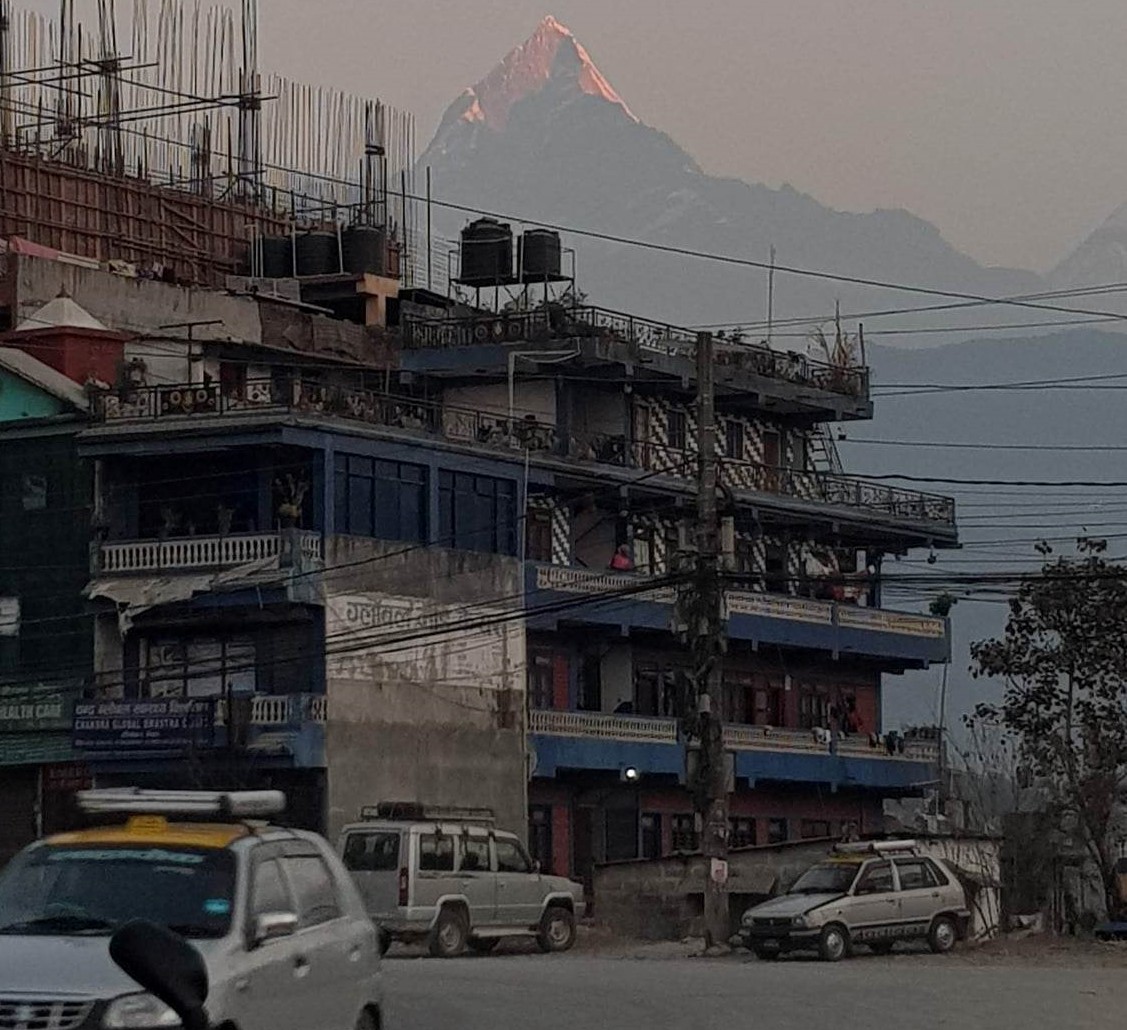 The driver, a resident of Ghachowk, was so responsive and friendly. On the way, we talked about Khumai Danda and various other matters. He said that the place became popular as normalcy returned after the Covid-19 pandemic. Lately, it has been drawing people from across the country, he said.
Though the driver was supposed to drop us at Ghachowk, he took us straight to Saripakha. We reached there at around 8 am. He also booked a hotel for us in Khumai Danda and also ordered lunch at Hilekharka.
Without wasting time, we started walking steep stone stairs from Saripakha. Just 10 to 15 minutes after leaving the beautiful hamlet, we got to see a scintillating view of Mt Machhapuchhre and Mt Annapurna.
The driver, a resident of Ghachowk, was so responsive and friendly. On the way, we talked about Khumai Danda and various other matters. He said that the place became popular as normalcy returned after the Covid-19 pandemic. Lately, it has been drawing people from across the country, he said.
Though the driver was supposed to drop us at Ghachowk, he took us straight to Saripakha. We reached there at around 8 am. He also booked a hotel for us in Khumai Danda and also ordered lunch at Hilekharka.
Without wasting time, we started walking steep stone stairs from Saripakha. Just 10 to 15 minutes after leaving the beautiful hamlet, we got to see a scintillating view of Mt Machhapuchhre and Mt Annapurna.
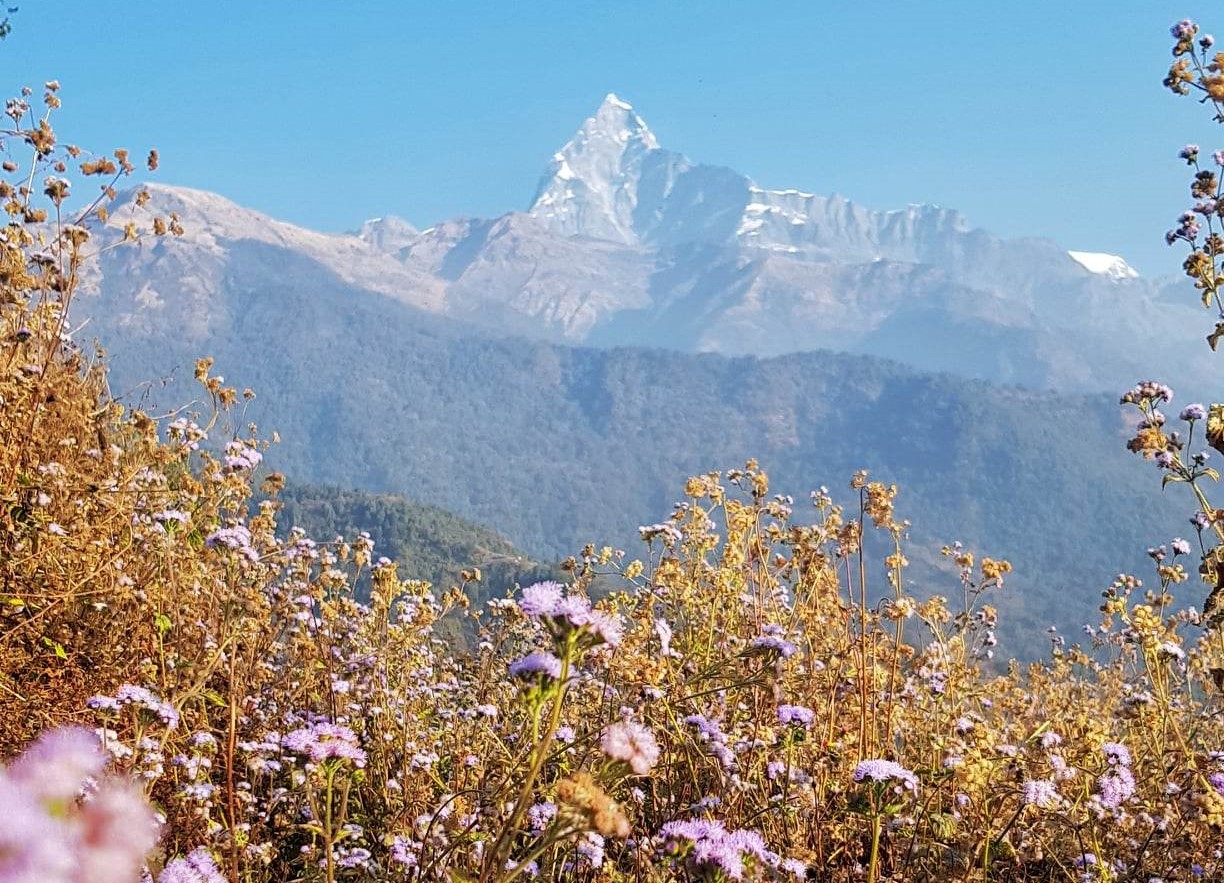 After walking together for around 30 minutes, the two girls faced difficulties in walking and decided to abort the journey. Soon after saying ‘ciao’ to them, we reached an open ground where we saw a traditional cow shed. A herd of buffaloes were grazing nearby under the morning sun.
Not treading for more than 15 minutes, we reached Tubu. Usually, people who start their trek from Ghachowk have their lunch at Tubu. But, as we started our journey from Saripakha, we decided not to stop there. After walking for around 1:30 hours, we reached Hilekharka at 10 am. While waiting for lunch, we opted to bask in the warmth of the morning sun, enjoying the panoramic view of high Himalayas.
After walking together for around 30 minutes, the two girls faced difficulties in walking and decided to abort the journey. Soon after saying ‘ciao’ to them, we reached an open ground where we saw a traditional cow shed. A herd of buffaloes were grazing nearby under the morning sun.
Not treading for more than 15 minutes, we reached Tubu. Usually, people who start their trek from Ghachowk have their lunch at Tubu. But, as we started our journey from Saripakha, we decided not to stop there. After walking for around 1:30 hours, we reached Hilekharka at 10 am. While waiting for lunch, we opted to bask in the warmth of the morning sun, enjoying the panoramic view of high Himalayas.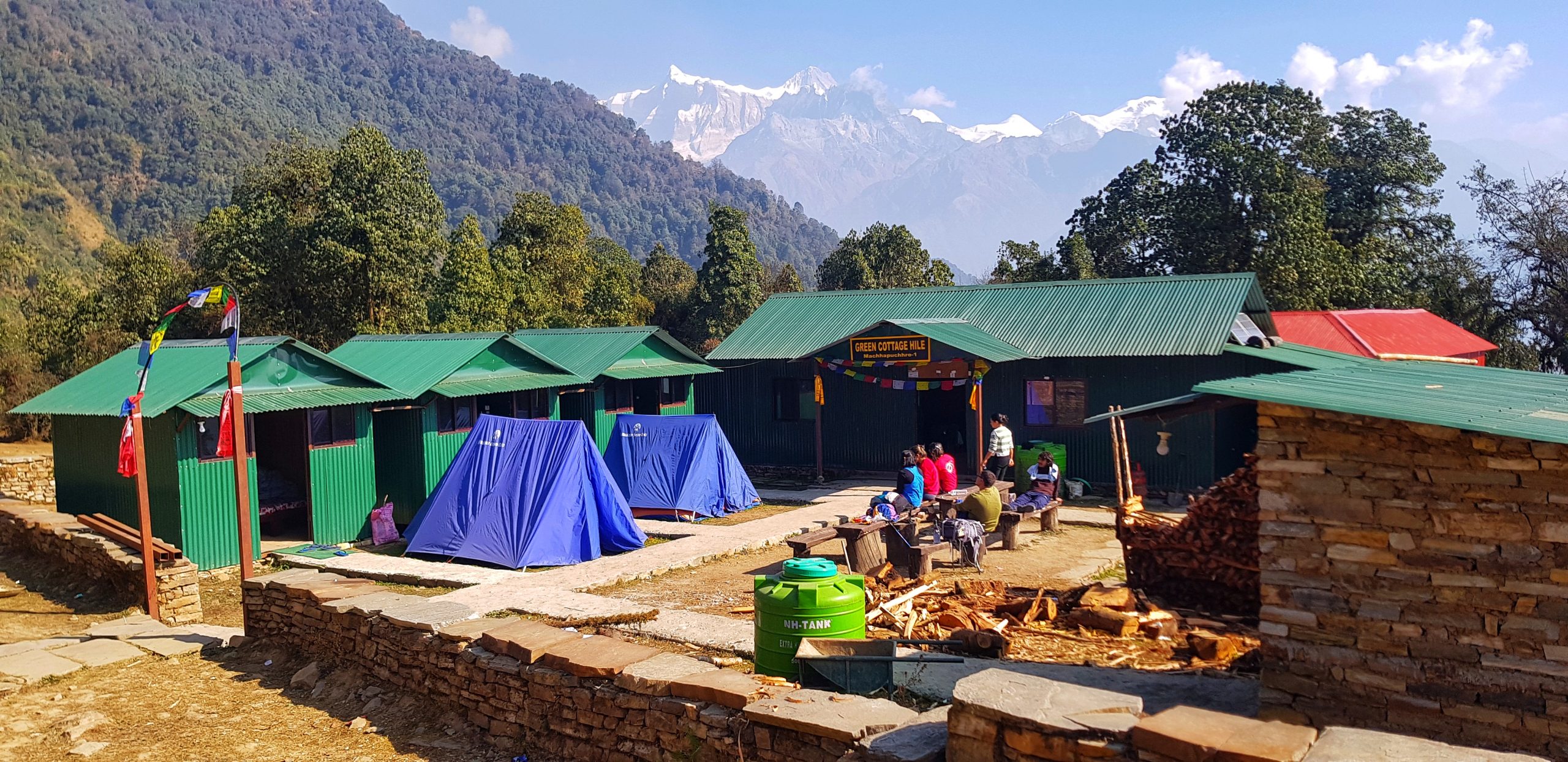 The nutritious and local lunch at the Green Cottage was out of the world.
The nutritious and local lunch at the Green Cottage was out of the world.
 We left Hilekharka at 11:30 am. Once we crossed Hilekharka, we started climbing a steep trail into the forest of rhododendron trees. For the time being, the forest was an immediate sunburn relief for us. We reached Chichimle at 12:30 pm.
As we trudged higher up to Deurali enjoying the pastoral beauty of the Bhurjung river and uninterrupted view of Mt Machhapuchhre and Mt Annapurna, we reached a place where some people were building a home stay. They offered us tea and snacks. We had tete-a-tete for around half-an-hour.
Saying goodbye to them with a promise to meet again in the future, we entered a dense forest. While walking into the forest, the sound of rustling leaves and twittering of birds recharged us. When we reached Lobruchu, some people were having noodles. We also planned to have something to muster energy but the weather suddenly became cloudy. With fear that the rain would make for a tough grind for us, we decided to reach Khumai Danda at the earliest.
It was just half-an-hour away from our destination, and snow started to fall. Though the snow brought chill air from the Himalayas ranges, we also felt lucky as the snowfall was the first of the season.
Soon after we reached Khumai Danda, Naran Dai, the owner of the Green Cottage, with a warm smile spread across his face welcomed us with masala tea and popcorn.
We left Hilekharka at 11:30 am. Once we crossed Hilekharka, we started climbing a steep trail into the forest of rhododendron trees. For the time being, the forest was an immediate sunburn relief for us. We reached Chichimle at 12:30 pm.
As we trudged higher up to Deurali enjoying the pastoral beauty of the Bhurjung river and uninterrupted view of Mt Machhapuchhre and Mt Annapurna, we reached a place where some people were building a home stay. They offered us tea and snacks. We had tete-a-tete for around half-an-hour.
Saying goodbye to them with a promise to meet again in the future, we entered a dense forest. While walking into the forest, the sound of rustling leaves and twittering of birds recharged us. When we reached Lobruchu, some people were having noodles. We also planned to have something to muster energy but the weather suddenly became cloudy. With fear that the rain would make for a tough grind for us, we decided to reach Khumai Danda at the earliest.
It was just half-an-hour away from our destination, and snow started to fall. Though the snow brought chill air from the Himalayas ranges, we also felt lucky as the snowfall was the first of the season.
Soon after we reached Khumai Danda, Naran Dai, the owner of the Green Cottage, with a warm smile spread across his face welcomed us with masala tea and popcorn.
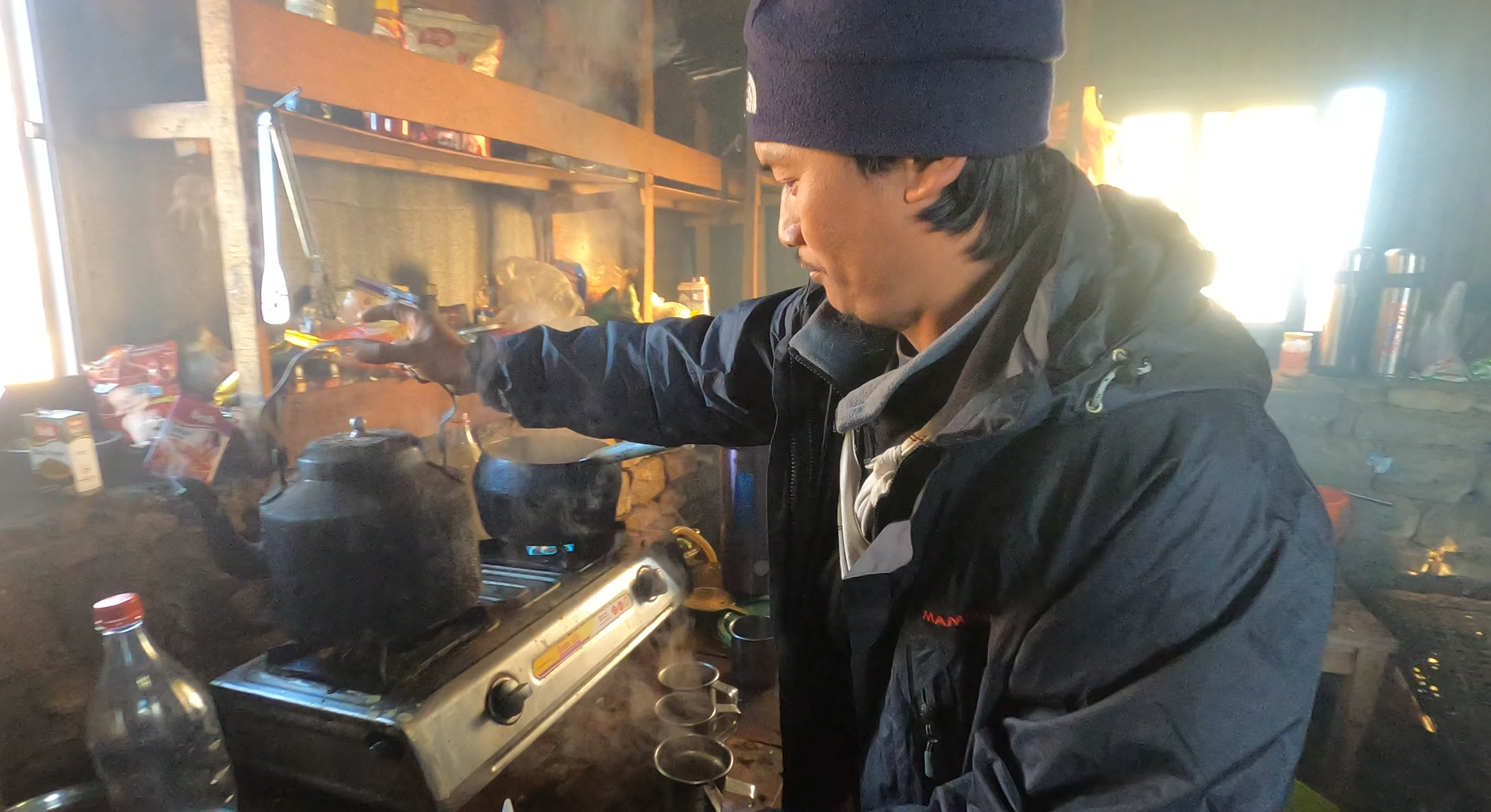 As the weather was cold, we went directly to the kitchen to sit around the fire.
Other hikers from Butwal and Pokhara were also relaxing in the kitchen. When they started singing and dancing, the environment became ebullient. The sad part of the journey was we could not see the sunset.
While staying in the kitchen, we made a decision that we would go to Korchan Danda (3,700 m) to see the sunrise if the weather becomes favorable. Otherwise, we would return to Pokhara. After having dinner, we went to bed.
The next morning at around 4, we saw stars twinkling in the sky. My mom told me that the weather would be clear. At around 6 o’ clock, we headed toward Korchan Danda.
When the sun started to rise above Mt Machhapuchhre to lift the mask of the night, the magical golden color made us forget all the pain and stress of our life. As we went higher, the beauty of the sun and the views also escalated. It was a dream-like moment and the best ever experience of my life.
As the weather was cold, we went directly to the kitchen to sit around the fire.
Other hikers from Butwal and Pokhara were also relaxing in the kitchen. When they started singing and dancing, the environment became ebullient. The sad part of the journey was we could not see the sunset.
While staying in the kitchen, we made a decision that we would go to Korchan Danda (3,700 m) to see the sunrise if the weather becomes favorable. Otherwise, we would return to Pokhara. After having dinner, we went to bed.
The next morning at around 4, we saw stars twinkling in the sky. My mom told me that the weather would be clear. At around 6 o’ clock, we headed toward Korchan Danda.
When the sun started to rise above Mt Machhapuchhre to lift the mask of the night, the magical golden color made us forget all the pain and stress of our life. As we went higher, the beauty of the sun and the views also escalated. It was a dream-like moment and the best ever experience of my life.
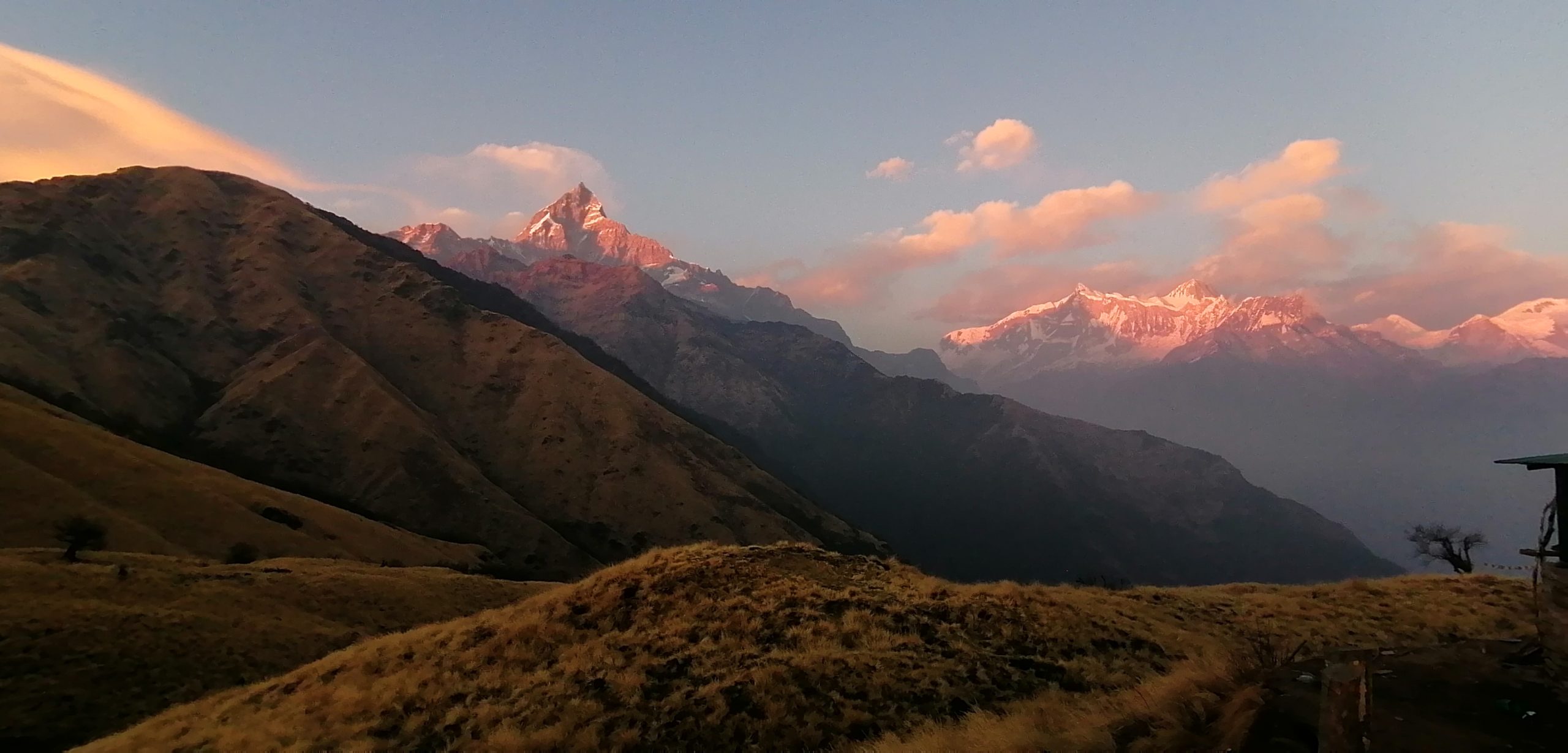 We spent some time glancing at the unlimited richness and beauty of the snow-capped mountains and nature. We played with the snow and also took photos and videos of pristine views of the Himalayas before returning to the hotel.
The local and authentic breakfast was waiting for us at the hotel. Some people had already left the guest house and some were preparing to leave. As the weather was bright and sunny, we decided to stay that day in Khumai Danda to behold the beauty of the sunset.
Coming out of the kitchen after having breakfast, we saw a herd of mules transporting water. A man, who was looking after the mules, said that he charged Rs 400 per mule from the hotel owner for ferrying the water. As we had nothing to do, we decided to go along with the man and the mules to see the source of water.
We spent some time glancing at the unlimited richness and beauty of the snow-capped mountains and nature. We played with the snow and also took photos and videos of pristine views of the Himalayas before returning to the hotel.
The local and authentic breakfast was waiting for us at the hotel. Some people had already left the guest house and some were preparing to leave. As the weather was bright and sunny, we decided to stay that day in Khumai Danda to behold the beauty of the sunset.
Coming out of the kitchen after having breakfast, we saw a herd of mules transporting water. A man, who was looking after the mules, said that he charged Rs 400 per mule from the hotel owner for ferrying the water. As we had nothing to do, we decided to go along with the man and the mules to see the source of water.
 We walked behind the mules for around an hour to reach the water source. After having lunch, we freshened up and relaxed watching clouds dancing above the gigantic Mt Machhapuchhre. As the evening slowly descended, the red glow of the setting sun started to cover the sky. In what could be termed the ‘moment of golden hour’, the view was outside of the realm of imagination.
We walked behind the mules for around an hour to reach the water source. After having lunch, we freshened up and relaxed watching clouds dancing above the gigantic Mt Machhapuchhre. As the evening slowly descended, the red glow of the setting sun started to cover the sky. In what could be termed the ‘moment of golden hour’, the view was outside of the realm of imagination.
 After having dinner, we went to bed to wake up early in the morning to see the sunrise. As there is a saying: just like the days, no two sunrises are the same, we felt like the sunrise on that morning was more beautiful than the previous day. That is why, one must see the sunrise and sunset from the Khumai Danda, the precious gift of nature.
Taking all the good memories with us, we headed toward Ghachowk from where we hopped onto a jeep and drove back to Pokhara. The breathtaking views of mountains, rich vegetation, culture and lifestyle of the people have made Khumai Danda, located on the lap of Mt Machhapuchhre, an idyllic destination among the trekkers in recent days.
Photos: Achitra Thieng
After having dinner, we went to bed to wake up early in the morning to see the sunrise. As there is a saying: just like the days, no two sunrises are the same, we felt like the sunrise on that morning was more beautiful than the previous day. That is why, one must see the sunrise and sunset from the Khumai Danda, the precious gift of nature.
Taking all the good memories with us, we headed toward Ghachowk from where we hopped onto a jeep and drove back to Pokhara. The breathtaking views of mountains, rich vegetation, culture and lifestyle of the people have made Khumai Danda, located on the lap of Mt Machhapuchhre, an idyllic destination among the trekkers in recent days.
Photos: Achitra Thieng
National Census 2021: Significant shift in the lifestyle and usage of amenities in Nepali households
There has been a significant shift in the lifestyle and usage of daily amenities by households in Nepal in the last 10 years. An increasing number of Nepali households are now using liquefied petroleum gas (LPG) as a primary fuel source for cooking, and there has been a marked rise in the number of Nepalis owning televisions, laptops/computers, mobile phones, cars, and motorcycles. According to the National Census 2021, which was made public on Friday, traditional fuels like firewood and cow dung are still in use, but there has been a noticeable increase in the adoption of LPG and electricity. The Census 2021 reveals that the percentage of households using LPG as their primary source of cooking fuel has increased from 21.03 percent in 2011 to 44.3 percent in 2021. In 2011, firewood was the most commonly used fuel source for cooking in Nepali households, with 64 percent of households relying on it. However, this figure has dropped to 51 percent in 2021, indicating a shift towards cleaner and more sustainable fuel alternatives. The Census 2021 indicates a significant decrease in the use of kerosene as a primary source of cooking fuel, from 1.03 percent of households in 2011 to just 0.05 percent in 2021. In 2011, biogas was used by 2.43 percent of households, but this percentage dropped to 1.2 percent in 2021. Similarly, the use of cow-dung as a primary fuel source for cooking decreased from 10.38 percent of households in 2011 to just 2.9 percent in 2021. Although the Census reports a significant increase in the adoption of cleaner fuel alternatives, the use of electricity as a primary cooking fuel remains low, with only 0.5 percent of households using it in 2021. The Census 2021 also shed light on interesting facts about the usage of amenities in Nepali homes. According to the census, Nepalis are increasingly opting for smartphones over basic mobile phones, with the ownership of the former surpassing the latter. Additionally, more Nepalis are investing in televisions, while radio ownership is declining. Thanks to the expansion of telecom infrastructure, mobile telephony has replaced basic telephony, leading to a surge in mobile handset ownership and internet subscribership over the last decade. As per the Census, the percentage of households with ordinary mobile phones has increased to 73.15 percent in 2021, up from 64.63 percent in 2011. Furthermore, 37.72 percent of households now have internet facilities, compared to just 3.33 percent in 2011. The percentage of households with computers or laptops has also seen an increase from 7.28 percent in 2011 to 15 percent in 2021. In terms of appliances, the percentage of households with televisions has risen from 36.45 percent in 2011 to 49.37 percent in 2021. Refrigerator ownership has also seen a significant increase, with the percentage of households owning one jumping from 7.16 percent in 2011 to 23.7 percent in 2021. The Census also reveals a significant increase in motorcycle ownership as a means of transport in the country. The percentage of households with bicycles has increased from 32.38 percent in 2011 to 35.21 percent in 2021. Meanwhile, motorcycle ownership has seen a tremendous increase, rising from 9.58 percent in 2011 to 27.3 percent in 2021. The percentage of households with cars, jeeps, or vans has also gone up from 1.57 percent in 2011 to 3.1 percent in 2021. An increasing number of Nepali households now have access to tap or piped water facilities, which is a positive development toward ensuring safe and clean drinking water for all. According to the census data, the percentage of households with access to tap or piped water facilities has increased from 47.78 percent in 2011 to 57 percent in 2021. In contrast, the percentage of households relying on wells or hand pumps for their drinking water has decreased from 35.1 percent in 2011 to 29.8 percent in 2021. The Census 2021 also revealed that access to electricity in Nepal has significantly improved over the last decade, thanks to the completion of more hydropower projects. The data shows that the percentage of households using electricity as their primary source of lighting has jumped from 67.3 percent in 2011 to an impressive 92.2 percent in 2021. As the access to electricity has increased, the use of kerosene as a source of lighting has witnessed a sharp decline. In 2011, 18.3 percent of households relied on kerosene as their primary lighting source, while in 2021, only 0.6 percent of households used this method. The census also revealed that the use of solar energy as the primary lighting source has decreased slightly, from 7.44 percent in 2011 to 6.6 percent in 2021. These figures indicate a significant improvement in access to electricity across the country, particularly in rural areas. The census provides important data on the country's labor force, showing that a significant portion of the population is engaged in economic activities. Of the total population of 23,958,868 aged 10 years or above, 15,689,777 persons (65.5 percent) are economically active, while 8,211,012 persons (34.3 percent) are not economically active. According to the census data, 9.4 percent of households in the country are involved in operating small-scale enterprises other than agriculture. Among these households, the majority operate trade/business (49.5 percent), followed by cottage industry (21.9 percent), service-related businesses (11 percent), transportation businesses (5.5 percent), and other types of small-scale enterprises (12 percent). Of the total population of 23,958,868 aged 10 years or above, 15,689,777 persons (65.5 percent) are economically active, while 8,211,012 persons (34.3 percent) are not economically active. Of the total economically active population of 15,689,777 persons aged 10 years or above, 11,038,105 persons (70.35 percent) are usually economically active, while 4,651,672 persons (29.65 percent) are not usually economically active. Of the total usually economically active population of 11,038,105, a majority of 10,270,447 persons (93.05 percent) are usually employed, while the remaining 767,658 persons (6.95 percent) are usually unemployed. Among the total population engaged in any economic activity, the majority (50.1 percent) are skilled workers in agriculture, forestry, and fishery, followed by elementary workers (23.0 percent), service and sales workers (5.8 percent), crafts and trade workers (5.6 percent), managers (5.1 percent), professionals (3.8 percent), plant and machine operators (2.7 percent), technician and associate professionals (1.9 percent), office assistants (1.3 percent), and armed forces (0.7 percent). According to the census, the majority of economically active individuals in Nepal are engaged in the agriculture industry, accounting for 57.3 percent. Among those engaged in any economic activity, the top five industries are agriculture, forestry, and fishing at 57.3 percent, followed by wholesale and retail trade, repair of motor vehicles and motorcycles at 12.5 percent, construction at 8.1 percent, other service activities at 3.9 percent, and manufacturing at 3.8 percent. The number of households owning four-wheelers (jeep/car/van) has increased in the last 10 years. As of 2021, there are 204990 households in the country that own a jeep/car/van, up from 85,135 households in 2011. The number of households owning motorcycles increased to 1816121 in 2021 from 519570 households in 2011. Similarly, the number of households owning television increased to 3291185 in 2021 from 1976603 households in 2011.
| Source of Fuel for Cooking Households using firewood as main source of fuel for cooking 2011 64 percent 2021 51 percent Households using LPG as main source of fuel for cooking 2011 21.03 percent 2021 44.3 percent Households using kerosene as main source of fuel for cooking 2011 1.03 percent 2021 0.05 percent Households using biogas as main source of fuel for cooking 2011 2.43 percent 2021 1.2 percent Households using electricity as main source of fuel for cooking 2011 0.08 percent 2021 0.5 percent Households using cow-dung as main source of fuel for cooking 2011 10.38 percent 2021 2.9 percent |
| Source of Lighting Households using electricity as the main source of lighting 2011 67.3 percent 2021 92.2 percent Households using kerosene as the main source of lighting 2011 18.3 percent 2021 0.6 percent Households using solar as the main source of lighting 2011 7.44 percent 2021 6.6 percent |
| Household Amenities Households having ordinary mobile phones 2011 64.63 percent 2021 73.15 percent Households having television 2011 36.45 percent 2021 49.37 percent Households having internet facility 2011 3.33 percent 2021 37.72 percent Households having refrigerator 2011 7.16 percent 2021 23.7 percent Households having computer/laptop 2011 7.28 percent 2021 15 percent Households having bicycle 2011 32.38 percent 2021 35.21 percent Households having motorcycle 2011 9.58 percent 2021 27.3 percent Households having car/jeep/van 2011 1.57 percent 2021 3.1 percent |
| Housing Ownership Households residing in their own housing units 2011 85.3 percent 2021 86 percent Households residing in rented housing units 2011 12.8 percent 2021 12.8 percent |
| Source of Drinking Water Household having tap/piped water facility 2011 47.78 percent 2021 57 percent Households having well/hand pump 2011 35.1 percent 2021 29.8 percent |
| Industry | Active Person |
| Trade/Business | 49.5 percent |
| Cottage | 21.9 percent |
| Service-related | 11 percent |
| Transportation | 5.5 percent |
| Other | 12 percent |
| Economically Active 65.5 percent Not Economically Active 34.3 percent |
| Usually Economically Active 70.35 percent Not Usually Economically Active 29.65 percent |
| Usually Employed 93.05 percent Usually Unemployed 6.95 percent |
| Occupation Economically Active Skilled Workers in Agriculture, Forestry & Fishery 50.1 percent Elementary Workers 23 percent Service & Sales Workers 5.8 percent Craft & Trade Workers 5.6 percent Managers 5.1 percent Professionals 3.8 percent Plant and Machine Operators 2.7 percent Technicians 1.9 percent Office Assistants 1.3 percent Armed Forces 0.7 percent |
| Industry | Active Person |
| Agriculture, forestry, and fishing | 57.3 percent |
| Wholesale & retail trade | 12.5 percent |
| Construction | 8.1 percent |
| Other Service Activities | 3.9 percent |
| Manufacturing | 3.8 percent |
| Province Household Koshi 25960 Madhes 16694 Bagmati 99854 Gandaki 24077 Lumbini 28824 Karnali 3039 Sudur Paschim 6542 Total 204990 |
| Province Household Koshi 294897 Madhes 394596 Bagmati 560736 Gandaki 160097 Lumbini 291415 Karnali 24473 Sudur Paschim 89907 Total 1816121 |
| Koshi | 649594 |
| Madhes | 504357 |
| Bagmati | 971974 |
| Gandaki | 394562 |
| Lumbini | 536004 |
| Karnali | 64558 |
| Sudur Paschim | 170136 |
| Total | 3291185 |

